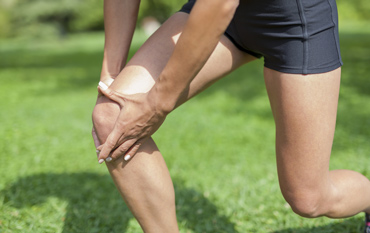Overuse Syndromes
Patellar Tendinopathy

Patellar tendinopathy – also called Jumper’s Knee – is a chronic inflammation of the patellar tendon’s insertion point on the kneecap. It usually occurs after overuse and is precisely diagnosable, as the pain is clearly localized at the lower tip of the kneecap.
Patellar tendinopathy is the most common knee condition in elite athletes and aspiring amateur athletes. Sports with high tensile loads on the patellar tendon are particularly susceptible to patellar tendinopathy. These include high jump and long jump, as well as ball sports like volleyball and basketball, weightlifting, and endurance running on hard surfaces.
Patellar Tendinopathy – Diagnosis
In addition to an initial clinical examination, imaging procedures such as magnetic resonance imaging (MRI) or an X-ray may also be used.
Patellar Tendinopathy – Treatment
In early stages of patellar tendinopathy, treatment is conservative, meaning non-surgical. Treatments may include:
- Anti-inflammatory medications
- Injections
- Rest
- Physical therapy
- Extracorporeal Shockwave Therapy
In severe cases, surgery should be considered.
Runner’s Knee
As the name suggests, runner’s knee frequently occurs in runners, jumpers, and other athletes such as skiers, cyclists, and soccer players. Runner’s knee refers to pain around the kneecap, which can also radiate. It encompasses a range of conditions such as anterior knee pain syndrome or patellofemoral malalignment.
In runners, pain usually appears only after a certain period of exertion.
Runner’s Knee – Diagnosis
To diagnose runner’s knee, an extensive patient consultation is first conducted, during which I will ask you about your sports activities that worsen your knee pain. This is followed by a clinical examination. In some cases, an X-ray or MRI may also be ordered.
Runner’s Knee – Treatment
The first step is to avoid activities that cause pain.
Treatment options include both non-surgical and surgical methods.
Conservative treatments may include:
- Rest
- Review of running style and footwear
- Orthotics
- Anti-inflammatory medications
- Injections
- Physical therapy
In a few cases, surgery is necessary. During an arthroscopy, damaged fragments are removed from the kneecap, and the kneecap is restored to its original alignment. This reduces pressure on the cartilage and supporting structures around the front of the knee, allowing muscle movements to occur pain-free again.
Are you looking for an experienced knee specialist in Vienna? Do not hesitate to contact me. My practice is located in the Wiener Privatklinik in the 9th district of Vienna.

Dr. Mark Schurz
CONTACT